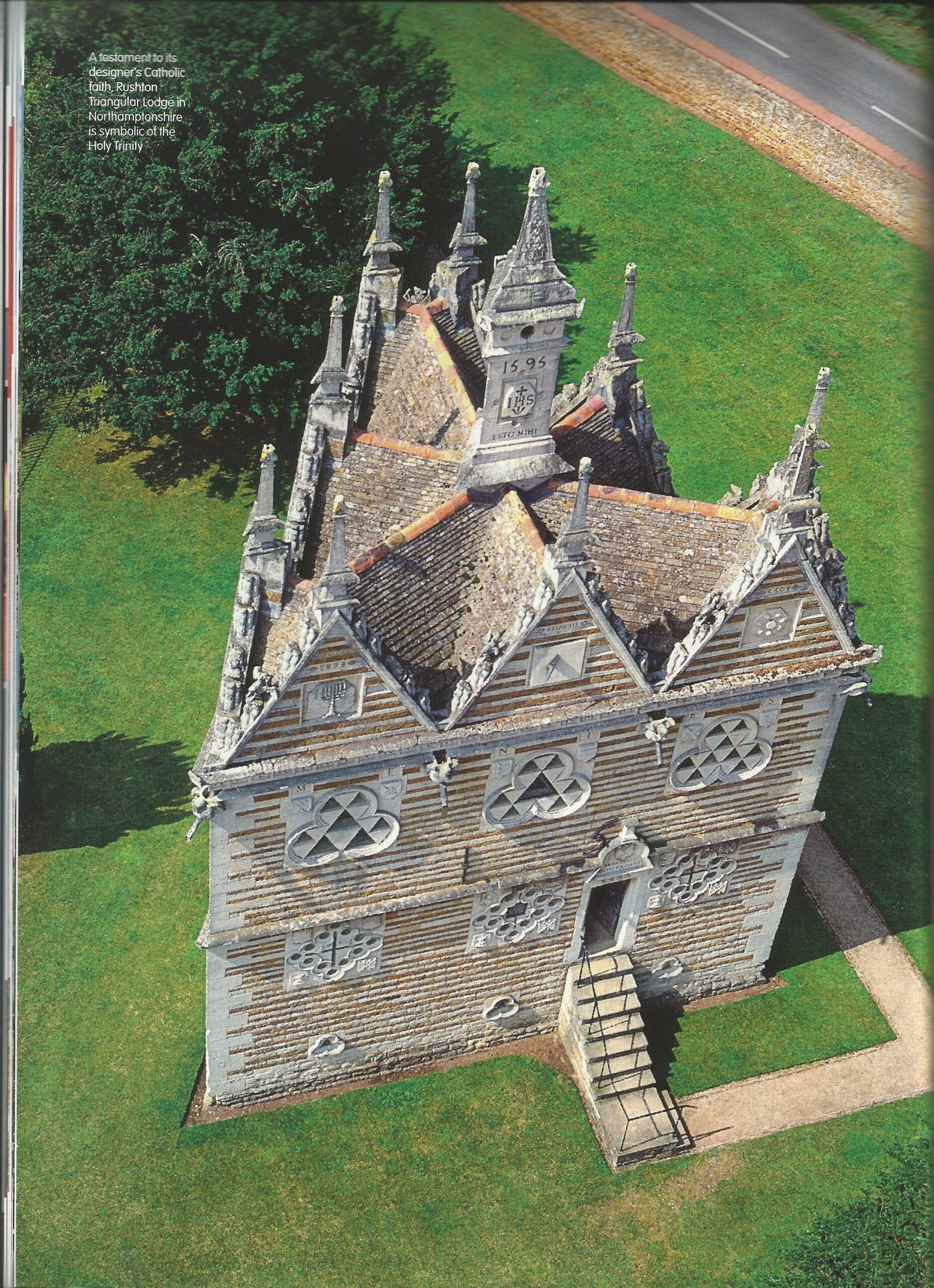Journey back in time and experience the magic of live music at the majestic Rochester Castle with Rochester Castle Concerts 2024. Uncover the stories and legacies of loved ones with the poignant tributes found within the Scarborough Evening News Obituaries.
The Triangular Testament: A Symbol of Defiance
Tucked away in the Northamptonshire countryside lies a truly unique Elizabethan enigma: Rushton Triangular Lodge. Built between 1593 and 1597 by Sir Thomas Tresham, this unconventional structure stands in stark contrast to the typical architecture of its time. More than just an oddly shaped building, it serves as a powerful testament to Tresham’s unwavering Catholic faith during a period of intense religious persecution in England. This article explores the history, design, and symbolism of this remarkable lodge, delving into the mind of its creator and the turbulent times in which he lived.
Tresham’s Trinitarian Cipher: Decoding the Design
The lodge’s triangular shape is no accident; it’s a deliberate and prominent symbol of the Holy Trinity—Father, Son, and Holy Spirit—a core belief in Catholicism. This architectural declaration was a bold move for Tresham, a devout Catholic living under the Protestant rule of Queen Elizabeth I. The number three, echoing the Trinity, is woven throughout the lodge’s design. Three sides, each measuring 33 feet (likely symbolizing Christ’s age at his crucifixion), three floors, three gables, and trefoil (three-lobed) motifs appear throughout. Even the chimneys are triangular, solidifying the symbolic significance of the number. Was this an act of quiet rebellion? A coded message to fellow Catholics? The stones themselves seem to whisper these secrets, inviting us to ponder their multiple potential meanings.
Whispers in Stone: Unraveling the Inscriptions
Further emphasizing the Trinitarian theme are the Latin inscriptions adorning the lodge’s walls. Each inscription is meticulously crafted to contain exactly 33 letters, yet another nod to the Trinity. One inscription asks, “Quis separabit nos a charitate Christi?” (“Who shall separate us from the love of Christ?” Romans 8:35), perhaps a plea for religious tolerance or a defiant affirmation of faith in the face of adversity. Above the entrance, Tresham’s family coat of arms is accompanied by the inscription Tres testimonium dant, which translates to “The number three bears witness.” The inscription cleverly incorporates Tresham’s name (“Tres”), suggesting a double meaning: “Tresham bears witness.” These inscriptions, like the structure itself, suggest a deliberate, almost obsessive focus on embedding religious symbolism into every aspect of the lodge’s design. Some scholars suggest these inscriptions might also contain coded messages or allude to esoteric beliefs prevalent during the Elizabethan era.
More Than a Folly: A Window into Elizabethan England
While some might dismiss Rushton Triangular Lodge as a mere folly, a closer examination reveals its profound historical significance. The alternating bands of dark and light limestone may symbolize the fluctuating religious landscape of Elizabethan England, the periods of relative peace interspersed with crackdowns on Catholic practice. The unique ground floor windows, each a lozenge shape with twelve circular openings surrounding a cruciform slit, framed by heraldic emblems, continue to intrigue scholars. What further secrets do these features hold? Ongoing research and exploration surrounding these sites continue to shed light on the beliefs and motivations of their enigmatic creator.
Unraveling the Mysteries: Sir Thomas Tresham and His Triangular Lodge
Sir Thomas Tresham’s story is one of faith, defiance, and architectural ingenuity. Imprisoned for 15 years for his Catholic beliefs, he embarked upon the construction of Rushton Triangular Lodge immediately following his release in 1593. This act can be interpreted as both a celebration of his regained freedom and a bold proclamation of his unwavering faith in a hostile environment. The lodge becomes more than just a building; it transforms into a symbol of resistance, a tangible representation of one man’s courage to stand by his convictions despite the risks.
A Deeper Dive into the Symbolism: The Power of Three
The pervasive presence of the number three extends beyond the lodge’s overall shape. The trefoil windows, reminiscent of three-leaf clovers, again allude to the Trinity. The 33-letter inscriptions, echoing the age of Christ at his crucifixion, add another layer of religious significance. These details, while seemingly minor, contribute to the intricate web of symbolism that permeates the structure. They suggest a meticulously planned design, where every element carries a symbolic weight, transforming the building into a complex and layered testament to Tresham’s faith.
Comparing Rushton and Lyveden: An Architectural Dialogue
Not far from Rushton lies Lyveden New Bield, another unfinished lodge designed by Tresham. While sharing some symbolic elements, the two structures differ significantly, suggesting a potential evolution in Tresham’s architectural approach and religious expression. Lyveden New Bield, though incomplete, features a cross-shaped design and incorporates symbolism related to the Passion of Christ and the Garden of Eden. Comparing these two sites provides valuable insights into the development of Tresham’s ideas, raising questions about the motivations and influences that shaped his unique architectural vision.
| Feature | Rushton Triangular Lodge | Lyveden New Bield |
|---|---|---|
| Shape | Triangular | Cross-shaped (unfinished) |
| Completion Status | Finished | Unfinished |
| Symbolic Focus | Trinity, Number 3 | Passion of Christ, Garden of Eden |
| Scale | Smaller, more compact | Larger, more ambitious |
Beyond the Obvious: Exploring Unanswered Questions
While much of the symbolism within Rushton Triangular Lodge is understood, some aspects remain open to interpretation, adding to its mystique. The heraldic devices surrounding the ground floor windows, for instance, warrant further investigation. Could they represent family alliances, hidden messages, or connections to broader esoteric traditions? Exploring these less-understood elements enhances the “unraveling” process, engaging visitors and scholars alike in an ongoing quest to decode the lodge’s full meaning.
Decoding the Symbolism: A Coded Message in Stone
Rushton Triangular Lodge stands as a powerful symbol of faith in an era defined by religious persecution. Its coded language, expressed through architectural elements and inscriptions, allowed Tresham to proclaim his beliefs without directly inviting further persecution. This act of covert defiance raises intriguing questions about the role of architecture as a vehicle for expressing and preserving religious beliefs during times of oppression.
A Secret Language: Communicating Through Architecture
In the context of Elizabethan England, with its atmosphere of secrets and hidden loyalties, the lodge’s complex symbolism takes on a new dimension. It served as a kind of secret handshake in stone, recognizable to fellow Catholics while remaining enigmatic to outsiders. This covert communication allowed a sense of community and shared faith to flourish discreetly amidst a hostile environment.
A Testament to Family and Faith: Tresham’s Personal Sanctuary
Having inherited Rushton Hall at a young age, Tresham developed a profound connection to his ancestral home. The lodge, built on the estate grounds, can be viewed as an extension of his personal identity, intertwining his faith, family history, and intellectual pursuits. Its unique design suggests a deliberate intention to create a space that reflected his inner world. Was it a personal sanctuary, a place for quiet contemplation and prayer, or perhaps a meeting place for fellow Catholics? The questions themselves are fascinating, offering glimpses into the mind of a man grappling with his faith in challenging times.
Uncovering Hidden Meanings: An Ongoing Exploration
The symbolism of Rushton Triangular Lodge extends beyond the obvious triangles and the recurring number three. The materials used, the lodge’s orientation on the estate, and even the specific placement of inscriptions all contribute to its layered meaning. Ongoing research continues to reveal new insights, inviting us to delve deeper into the complexities of this architectural enigma. The lodge serves as a reminder that even seemingly simple structures can hold profound meaning, waiting to be uncovered by those who take the time to look and listen.
Exploring the History: Faith, Persecution, and Architectural Expression
Sir Thomas Tresham’s Rushton Triangular Lodge provides a unique lens through which to explore the complex interplay between faith, architecture, and the socio-political landscape of Elizabethan England. The lodge’s existence is inextricably linked to the religious tensions of the era, serving as both a testament to faith and a subtle form of protest against the established church.
A Bold Statement in Turbulent Times
Building such an overtly Catholic structure during the reign of Protestant Queen Elizabeth I was a daring act. Tresham, having endured years of imprisonment for his beliefs, demonstrated remarkable courage in choosing this form of architectural expression. The lodge’s construction raises questions about the limits of religious tolerance in Elizabethan England and the various ways individuals navigated these constraints.
The Lodge as Sanctuary: A Space for Covert Worship?
Some historians suggest that Rushton Triangular Lodge may have also functioned as a clandestine meeting place for Catholics, offering a sanctuary for worship and community during a time of persecution. This theory, while not definitively proven, adds another layer of intrigue to the lodge’s history, highlighting the resourcefulness and resilience of religious minorities in the face of adversity.
Rushton Triangular Lodge: A Legacy in Stone
Rushton Triangular Lodge stands not just as an architectural curiosity, but as a powerful symbol of faith, resilience, and the enduring influence of belief on human expression. It invites us to explore the complexities of religious history and to consider the diverse ways individuals have sought to express and preserve their faith across generations. Its unique triangular design and intricate symbolism continue to captivate visitors and scholars, inspiring ongoing research and ensuring that the story of Sir Thomas Tresham and his remarkable triangular lodge continues to be told.
Visiting Rushton Triangular Lodge: A Practical Guide
Intrigued by the enigma of Rushton Triangular Lodge? Here’s a guide to help you plan your visit:
| Detail | Information |
|---|---|
| Location | Rushton, near Desborough, Northamptonshire NN14 1RP |
| Contact | English Heritage Customer Services |
| Management | English Heritage |
| Opening Times | Check the English Heritage website for current hours. |
| Ticket Prices | Check the English Heritage website for current pricing. |
| Parking | Information about nearby parking is available online or by contacting English Heritage. |
| Accessibility | Consult the English Heritage website or contact them directly for accessibility information. |
| Group Visits | Contact English Heritage in advance for group visit arrangements. |
Don’t miss nearby Kirby Hall, another fascinating historical site. Remember your camera to capture the unique architecture and intricate details of Rushton Triangular Lodge. Explore the grounds, ask questions, and delve into the history that surrounds this remarkable building. Perhaps you’ll discover your own interpretation of Tresham’s triangular testament.

















2 thoughts on “Rushton Triangular Lodge: Unraveling the Elizabethan Enigma of Faith and Architecture”
Comments are closed.